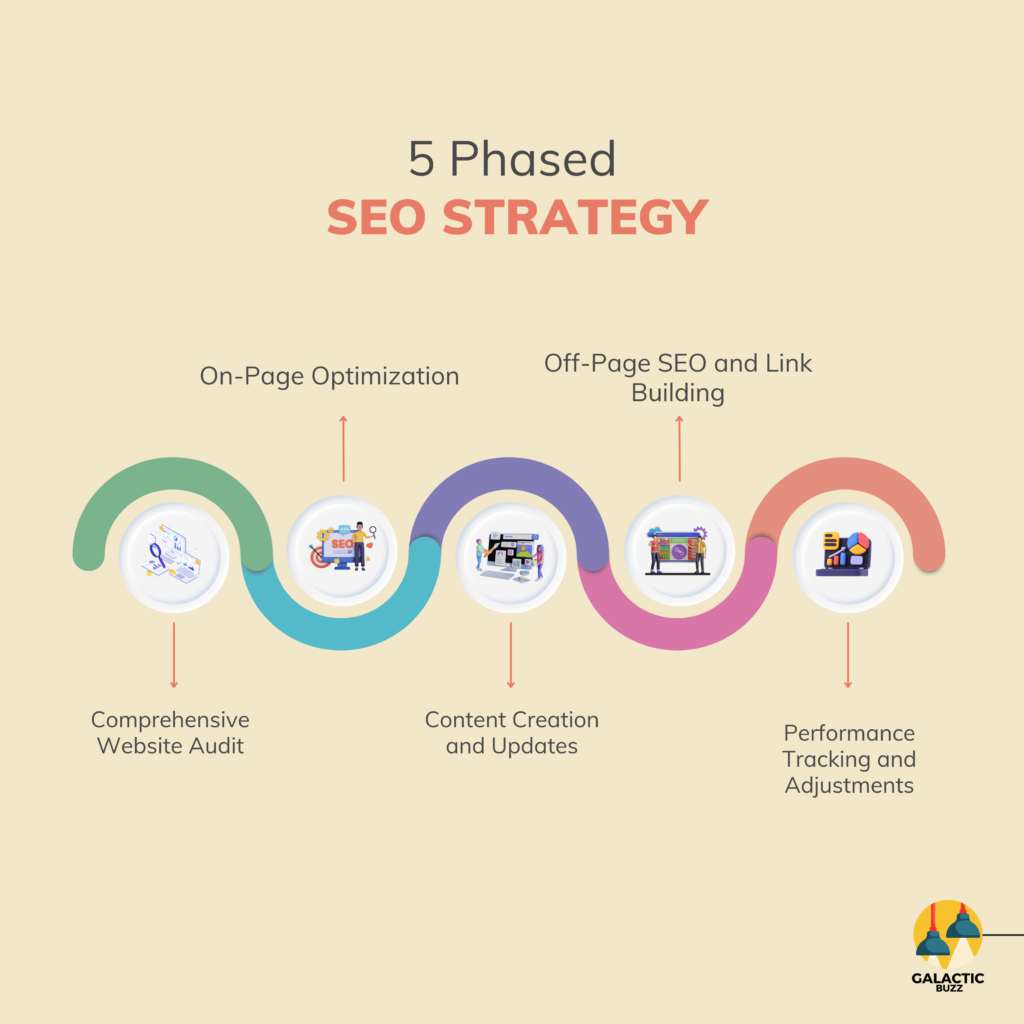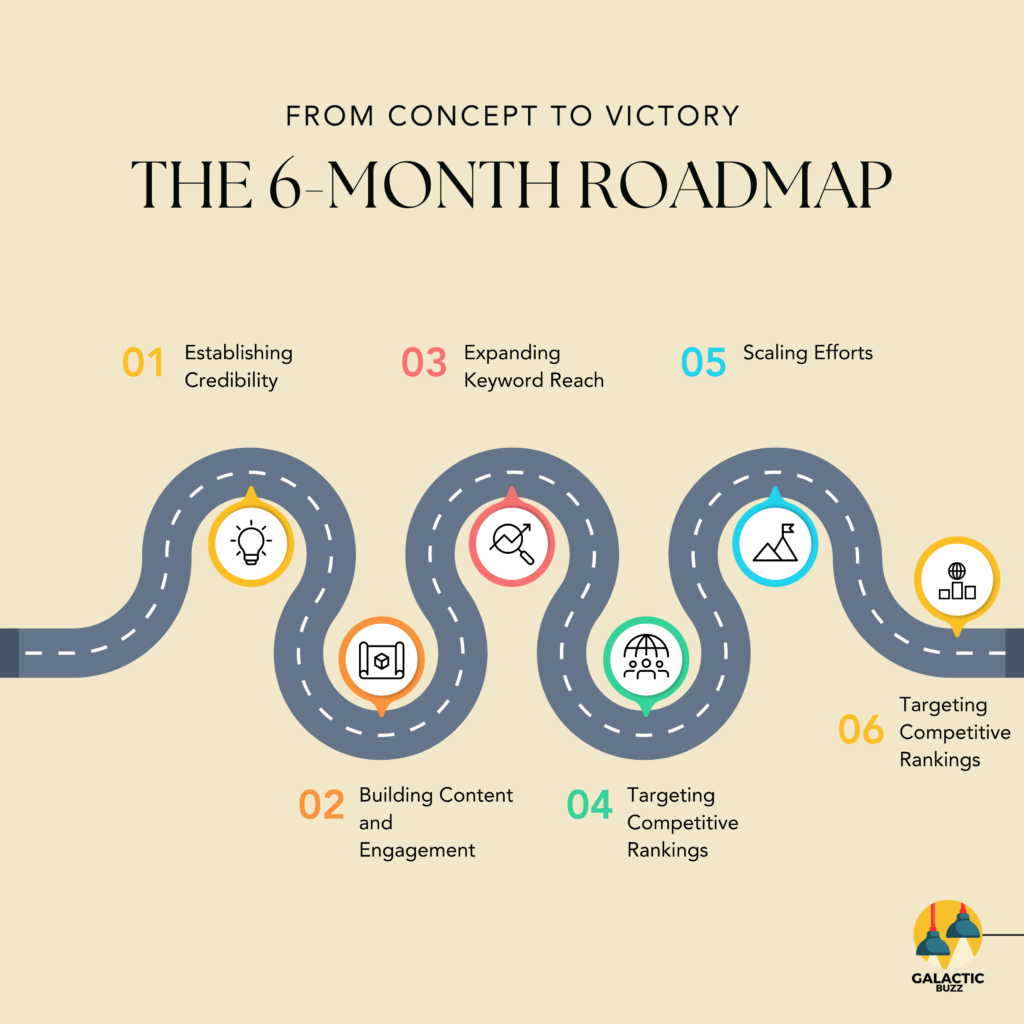
Search Engine Optimization (SEO) is the cornerstone of digital success, ensuring your website is visible, authoritative, and consistently attracting traffic. For businesses with a new website, however, the journey is often challenging due to Google’s sandbox effect, which can temporarily suppress rankings for newer domains.
At Galactic Buzz, we believe in building a strong SEO foundation that paves the way for long-term success. Our structured six-month SEO plan is designed to systematically tackle challenges, optimize your website, and deliver measurable results. In this blog, we’ll break down our approach, explain the rationale behind each step, and show how we help businesses achieve sustainable growth through SEO.
Why SEO Needs a Strategy
SEO isn’t just about keywords and rankings. It’s a comprehensive process involving technical expertise, engaging content, and data-driven decisions.
The Key Priorities of a New SEO Strategy
- Building Credibility: Establishing trust with search engines through quality backlinks and content.
- Targeting the Right Audience: Ensuring your website reaches users actively searching for your products or services.
- Sustained Growth: Laying a foundation for long-term traffic and visibility.
Our six-month plan is meticulously crafted to address these priorities step by step.
Phase 1: Comprehensive Website Audit
Before optimizing, we perform a thorough audit to understand the current state of your website. This ensures we tackle any technical, content-related, or structural issues before moving forward.
What We Analyze in the Audit
- Technical SEO:
- Page speed and load times.
- Mobile usability and responsiveness.
- Crawl errors, broken links, and sitemap accuracy.
- Content Review:
- Evaluating the quality, relevance, and optimization of existing pages.
- Identifying gaps in content for targeted keywords.
- Competitor Analysis:
- Benchmarking against competitors to identify missed opportunities.
- Studying their backlinks, keywords, and content strategies.
Why a Website Audit Matters
The audit helps us prioritize tasks and fix issues that could hurt rankings. For instance, a slow-loading website or broken links can significantly impact user experience and SEO performance.
Phase 2: On-Page Optimization
Once we have a clear roadmap, the next step is optimizing the elements directly on your website. On-page SEO ensures search engines understand your content and users have a seamless experience.
Key On-Page Optimizations
- Meta Tags:
- Writing compelling title tags and meta descriptions that align with target keywords.
- Example: A page targeting “tax preparation tips” might have a title like: “Expert Tax Preparation Tips for Small Businesses in the U.S.”
- Keyword Placement:
- Strategically placing keywords in headers, body text, and URLs without overstuffing.
- Image Optimization:
- Adding descriptive alt tags.
- Compressing images for faster load times.
- Renaming files to include target keywords (e.g., “tax-preparation-guide.jpg”).
- Internal Linking:
- Connecting pages on your site to improve navigation and distribute link equity.
Why On-Page SEO Matters
On-page SEO ensures your website is both search-engine-friendly and user-friendly, which is crucial for improving rankings and retaining visitors.
Phase 3: Content Creation and Updates
Content is the backbone of any successful SEO strategy. Search engines reward websites that consistently publish high-quality, relevant content that addresses user queries.
Steps in Content Optimization
- Blog Creation:
- Publishing 1–2 long-form blogs monthly targeting specific keywords and audience needs.
- Example: For an accounting firm, we might write “Top Accounting Tips for Small Businesses in 2024.”
- Content Refresh:
- Updating older content with new data, keywords, and improved readability.
- Engaging Formats:
- Incorporating visuals, infographics, and FAQs to enhance user engagement.
Why Content Matters for SEO
Great content not only attracts visitors but also establishes your brand as an authority in your industry. It’s a long-term investment in organic traffic and customer trust.
Phase 4: Off-Page SEO and Link Building
Off-page SEO involves building your website’s reputation by earning backlinks and engaging with external platforms.
How We Build Links and Authority
- Backlink Outreach:
- Securing 15–20 high-quality backlinks monthly from authoritative sites.
- Prioritizing industry-specific links to boost relevance.
- Local SEO:
- Listing your business in local directories like Google My Business.
- Targeting location-specific keywords such as “best accountants in Los Angeles.”
- Community Engagement:
- Sharing content on forums, LinkedIn, and industry blogs to drive traffic and build relationships.
Why Off-Page SEO is Critical
Backlinks act as votes of confidence for your website, signaling to search engines that your content is valuable and trustworthy.
Phase 5: Performance Tracking and Adjustments
SEO is a continuous process. Regular tracking and adjustments ensure our strategies stay effective as search algorithms evolve.
Tools We Use for SEO Monitoring
- Google Analytics: Tracks user behavior, traffic sources, and conversions.
- Google Search Console: Monitors keyword performance and indexing issues.
What Metrics We Track
- Traffic growth over time.
- Improvements in keyword rankings.
- User engagement metrics like bounce rate and average session duration.
Why Tracking Performance is Key
Data-driven insights allow us to refine our approach, focusing on what’s working and addressing any weaknesses.
The 6-Month Roadmap

Month 1: Establishing Credibility
- Perform a comprehensive website audit.
- Fix technical issues and optimize key pages.
- Begin backlink outreach.
Month 2: Building Content and Engagement
- Publish engaging blog posts targeting niche queries.
- Strengthen internal linking.
- Drive traffic through social sharing and community posts.
Month 3: Expanding Keyword Reach
- Optimize underperforming content.
- Target local SEO keywords.
- Publish in-depth guides or thought leadership content.
Month 4: Targeting Competitive Rankings
- Secure backlinks from high-authority domains.
- Focus on cornerstone content and rich snippets.
Month 5: Scaling Efforts
- Publish comparison posts and case studies to attract new audiences.
- Refine strategies based on performance data.
Month 6: Analyzing Results and Planning Ahead
- Measure traffic, conversions, and keyword rankings.
- Plan for advanced strategies like voice search optimization or paid campaigns.
Expected Results After 6 Months
By the end of the six months, here’s what you can expect:
- Organic Traffic: 50–100 visitors per month.
- Keyword Rankings: Long-tail keywords on the 1st–2nd page; short-tail keywords visible on the 3rd–5th page.
- Lead Generation: Increased inquiries via local SEO and targeted content.
The Bottom Line
SEO is not a sprint—it’s a marathon that requires patience, strategy, and consistent effort. Our six-month plan ensures your website doesn’t just rank but also thrives in the competitive digital landscape.
Ready to transform your online presence? Contact us today and let’s get started on your journey to SEO success!


